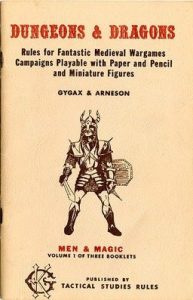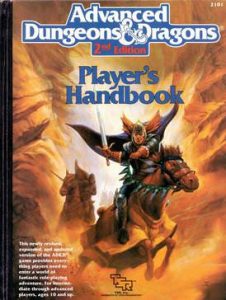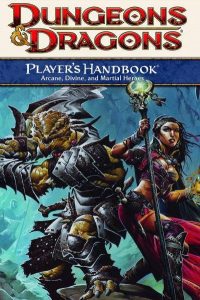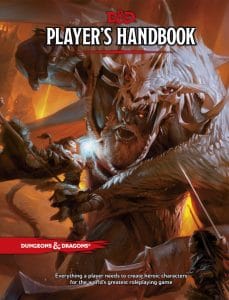Dungeons and Dragons is a 40-year-old game so it should be slowing down due to a bad knee. But a darned thing is happening: it’s drawing in tons of brand new players.
These new players are enjoying the 5th edition of the game (D&D 5e), so they may not be familiar with the history of D&D and how the game got to where it is today.
I realize 82% of readers went narcoleptic at the mere mention of the word “history,” but let’s have some fun with this. If you’ve played any game–tabletop or video–and you’ve leveled a character, had hit points, chosen a race or class, used a spell, or added equipment or gear to a character, then that game owes a debt to D&D. Compound interest over 40 years means that’s a biiiiiiig debt that modern gaming owes to D&D.
Indeed, it’s truly nigh impossible to overstate the influence Dungeons and Dragons has has on all of gaming, so let’s spare a thought for how the game got started.
A Brief Primer of the Different Editions of Dungeons and Dragons
D&D 1st Edition (1e)

The All Father of gaming, Gary Gygax, was an old school wargamer, meaning soldiers on a grid. In 1974 he released 3 little booklets that were a mashup of J.R.R. Tolkien and a miniatures wargame, Chainmail.
That first 1974 release featured only a handful of the elements that the game is known for today. It only had three character classes (fighting-man, magic-user, and cleric); four races (human, dwarf, elf, and hobbit); and just a handful of monsters.
But D&D was a radically new gaming concept at the time, so it was just getting warmed up.
The release of the Greyhawk supplement (Gary Gygax’s home-brew creation) removed the game’s dependency on the Chainmail rules, and made it much easier for new, non-wargaming players to grasp the concepts of play. Then supplements published over the next two years greatly expanded the rules, character classes, monsters, and spells.
New options were periodically published in a magazine, The Dragon.
An updated version of D&D was released as Advanced Dungeons & Dragons (AD&D), reorganizing the game rules into three hardcover rulebooks. Compiled by Gary Gygax between 1977 and 1979, the books were the Monster Manual (1977), the Player’s Handbook (1978), and the Dungeon Master’s Guide (1979).
Gygax had formed the company TSR and was cranking out books, adventures, and boxed sets at a pace that was too furious and confusing to fully recount here. Let’s just agree it was awesome, as AD&D was a beautiful thing throughout the 80s. They were still experimenting, adding rules, and writing some of the adventures that are classics to this day.
D&D 2nd Edition (2e)

Then, in 1989, a small team of designers at TSR lead by Zeb Cook created the second edition of the AD&D game. Numerous mechanical changes were made to the game, including modifications to the combat system. The most memorable of which may have been the THAC0 (“To Hit Armor Class ‘0’”) number, a simplification of 1st edition’s attack matrix tables.
The release of AD&D 2nd Edition also corresponded with some important cultural pressures that affected TSR. An effort was made to remove aspects of the game which had attracted negative publicity, most notably the removal of all mention of demons and devils, and the elimination of character classes like the assassin.
The 2nd Edition stressed heroic roleplaying and player teamwork and the target age of the game was also lowered, being aimed primarily at teenagers.
D&D 3rd Edition (3e)
In the year 2000, D&D went pro, with TSR having been acquired by Wizards of the Coast. The word “advanced” was dropped and the new 3rd edition (or 3e for short) was back to being named just Dungeons & Dragons. Underlying 3e was a system (the d20 System) that went all in on the 20-sided dice, and went the other way with armor class, making a higher number better.
New character options were introduced. Skills and a new system of feats are introduced. And, most notably, the d20 System was presented under the Open Game License, which made it an open source system that allowed for 3rd party D&D-compatible content. Remember this for later.
In July 2003, a revised version of the 3rd edition D&D rules (termed v. 3.5) was released that incorporated numerous little rule changes, even as the basic rules were fundamentally the same, and many monsters and items are compatible (or even unchanged) between those editions.
D&D 4th Edition (4e)

On August 15, 2007, WotC announced the development of D&D 4th edition, and the Player’s Handbook, Monster Manual, and Dungeon Master’s Guide were released in June of the next year.
Inspired by video games like World of Warcraft, 4th edition saw a major overhaul of the game’s systems. Combat became very tactical and reinforced the use of squares to express distances.
Changes in spells gave all classes a similar number of at-will, per-encounter and per-day powers. A system of “healing surges” were introduced.
The initial print run of the 4th edition sold out during preorders, but things went south from there. Many players instead chose to continue playing older editions, particularly v3.5.
Then the Github code was forked. Using the Open Game License, the Pathfinder Roleplaying Game was first published in 2009 by Paizo Publishing. It was intended to be backward-compatible with D&D v. 3.5 while adjusting some rules balance.
This earned it the nickname “version 3.75” by fans.
Powered by their Adventure Paths, Pathfinder became the best-selling role playing games in the industry, and D&D 4e became the game that ended up in used bookstores. This happened despite Wizards of the Coast releasing an Essentials line of the D&D 4th edition rule set in 2010 to provide simple player character options intended for first-time players.
D&D 5th Edition (5e)
But you can’t keep the world’s first RPG down for long. In January 2012, Wizards of the Coast announced a new edition of the game, developed in part by a massive open playtest.
The D&D 5e Starter Set (we review it here) was released on July 15, 2014, and featured the adventure module Lost Mine of Phandelver. Shortly thereafter were the edition’s three core rulebooks: The Player’s Handbook, the Monster Manual, and the Dungeon Master’s Guide.

Mechanically, 5th edition pulls inspiration heavily from prior editions, while also introducing some new mechanics intended to simplify ease of play.
Skills, weapons, and saving throws now all use a single proficiency bonus that increases as level increases. Multiple defense values of 3e have been removed, returning D&D to a single defense value of armor class.
The “advantage/disadvantage” mechanic was introduced, streamlining conditional modifiers into a simpler mechanic: rolling two d20s for a situation and taking the higher of the two for “advantage” and the lower of the two for “disadvantage.”
Even at age 40, D&D is in fantastic shape. It’s streamlined like never before, which is understandable, as it’s been on a long run.
Pick up a copy. Of course you can get the excellent current stuff now. And please do, you’ll love it: 5e Player’s Handbook (or even Pathfinder). And Noble Knight is a game store that specializes in out of print classics. They have it all: 4e, 3e, 2e, 1e.

